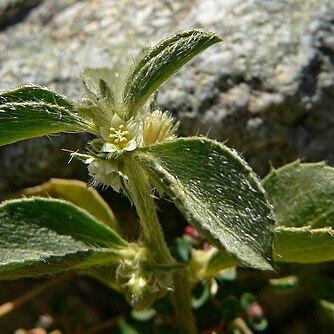Shrubs or herbs; monoecious (rarely dioecious); stems and foliage with in-dumentum of bifurcate (malpighiaceous) hairs, often with purplish pigment. Leaves alternate; petioles short; stipules small; blades not glandular, entire or dentate. Inflorescences short, racemiform, bisexual, with one to several basal 9 flowers; bracts small, subtending single flowers. Staminate flowers with calyx usually 5-lobed, valvate in the bud; petals 5, clawed at base, more or less adnate to base of staminal column; disc dissected, segments opposite the calyx-lobes; stamens 5-15, monadelphous, the anthers 1-2(-3) seriate, 1-3 filiform staminodia some-times present atop the column; pollen grains oblate, tectate, 3-or 4-colporate, bilaterally symmetrical; pistillode absent. Pistillate flowers with calyx 5-parted, the lobes imbricate; petals 5, imbricate, entire, sometimes reduced; disc ? dis-sected into sometimes elongated segments; ovary of 3 carpels, the ovules 1 in each locule, the styles free or basally connate, bifid, the style-branches ? dilated at the tips. Fruits capsular; seeds subglobose, foveolate to reticulate, ecarunculate, endosperm present, the embryo straight, the cotyledons broader than the radicle.

